Xanthos - A Great City from Homer's Iliad
- Mika Vepsalainen
- Jun 8, 2024
- 2 min read
Join us for a visit to one of the most remarkable ancient cities in today’s Turkey. Mentioned in the Iliad, Xanthos has seen the Lycians, the Persians, the Greek and the Romans and much more.

Xanthos, also known by scholars with its Lycian name Arna, was an ancient city near the present-day village of Kınık in Turkey. It is one of the oldest cities referred to in Homer’s”Iliad”. The acropolis of Xanthos dates from the 8th century BCE and the city was known to be Lycia’s largest. The ruins are located on a hill on the left bank of River Xanthos. One of the most notable features on the site is the number and quality of the surviving tombs, largely thanks to which, Xanthos was added to the UNESCO World Heritage list in 1988 together with nearby Letoon (soon to be released in our revieww, too).
The city was a Lycian centre of culture and commerce, and continued so for the Persians, Greek and Romans who in turn conquered the region. Xanthos influenced its neighbours architecturally; for instance, the Nereid Monument directly inspired the Mausoleum at Halicarnassus in Caria.
According to Herodotus, the Persians defeated the Lycian army in about 540 BC. The Lycians destroyed their acropolis, killed their wives, children and slaves, before engaging the enemy in a suicidal attack. Alexander the Great marched over the mountains to Xanthos where representatives from each of the cities of the Lycian League personally offered the Lycians' submission. In 42 BC, Brutus came to Lycia and besieged Xanthos. The city was once again destroyed and only 150 Xanthian men survived the carnage around 42 BC. Later, Mark Antony rebuilt the city.
Most of the buildings visible today were built during the Later Empire. The town took on a grid plan. A large piazza with porticoes was built in the west, probably where the classical agora was. In the later Roman Period, Xanthos together with the rest of Lycia, truly prospered and luxury houses were built on the Lycian acropolis. Several churches were also built, including a large basilica, a small chapel, and another basilica on the acropolis.
After the Christian church took over, Xanthos was placed under the Metropolitan Archbishopric of Myra in the Eastern Orthodox Church. Its last known bishop was Father Ignatios, later Metropolitan of Libya under the Patriarchate of Alexandria from 1863 to 1884. Incidentally, the Catholic Church restored the diocese in 1933.
Excavations at Xanthos have shown that wooden structures were destroyed in c. 470 BC and the city was later rebuilt in stone. You will find the Nereid Monument, the Tomb of Payava and the original sculptures of the Harpy Tomb in the British Museum today while the Harpy Tomb in Xanthos now exhibits replica reliefs.
The Xanthian Obelisk is a trilingual stele was found in the city. It records an older Anatolian language conventionally known as the Milyan.
At the entrance gate, there is a WC, souvenir shop and refreshment stand. Like many archaeological sites, Xanthos is not suited for visitors in wheel chairs.
Kınık Village, Kaş, Antalya


















